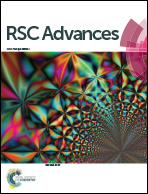Important factors for effective use of carbon nanotube matrices in electrochemical capacitor hybrid electrodes without binding additives†
Abstract
Various capacitive particles are currently available for use in electrochemical capacitors, but their electrical conductivities are typically low and require enhancement. Carbon nanotube (CNT) matrices can be used to fabricate self-supporting electrodes without binding or conducting additives. Herein, liquid dispersion and subsequent vacuum filtration were used to prepare thick (∼100 μm) hybrid electrodes of activated carbon (AC) and CNTs. Factors including CNT type, AC particle size, solvent, and surfactant strongly affected the capacitance and rate performance of the hybrid electrodes. Different solvents and types of CNTs were best suited for pure CNT electrodes and AC–CNT hybrid electrodes; single-wall CNTs (SWCNTs) with a strong dispersant produced CNT electrodes with the best performance among pure CNT electrodes. Meanwhile, few-wall CNTs (FWCNTs) with a weak dispersant produced AC–CNT hybrid electrodes with the best performance among hybrid electrodes. Addition of 10 wt% FWCNTs to AC yielded a self-supporting hybrid electrode with improved performance (132 F g−1, 58 F cm−3, 0.70 F cm−2 at 100 mV s−1) compared with that of a conventional AC electrode with conducting and binding additives (74 F g−1, 26 F cm−3, 0.60 F cm−2 at 100 mV s−1), and a pure electrode of expensive SWCNTs (52 F g−1, 26 F cm−3, 0.26 F cm−2 at 100 mV s−1).


 Please wait while we load your content...
Please wait while we load your content...